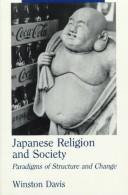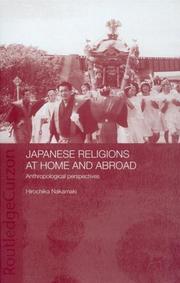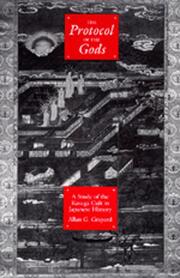| Listing 1 - 5 of 5 |
Sort by
|
Book
ISBN: 0520962834 9780520962835 9780520287778 Year: 2018 Publisher: Oakland, California
Abstract | Keywords | Export | Availability | Bookmark
 Loading...
Loading...Choose an application
- Reference Manager
- EndNote
- RefWorks (Direct export to RefWorks)
Japan: History and Culture from Classical to Cool provides a historical account of Japan's elite and popular cultures from premodern to modern periods. Drawing on the most up-to-date scholarship across numerous disciplines, Nancy K. Stalker presents the key historical themes, cultural trends, and religious developments throughout Japanese history. Focusing on everyday life and ordinary consumption, this is the first textbook of its kind to explore both imperial and colonial culture and offer expanded content on issues pertaining to gender and sexuality. Organized into fourteen chronological and thematic chapters, this text explores some of the most notable and engaging aspects of Japanese life and is well suited for undergraduate classroom use.
Popular culture --- Japanese influences. --- Japan --- History. --- asian studies. --- colonial japan. --- cultural history of japan. --- gender and sexuality in japan. --- haeian aristocracy. --- history of japan. --- history of japanese religion. --- imperial japan. --- japan as cultural superpower. --- japan studies. --- japanese culture. --- japanese history and culture textbook. --- japanese history. --- japanese life. --- japanese religion. --- japanese studies. --- modern japan. --- popular culture japan. --- premodern japan. --- religions of japan. --- tokugawa official culture.

ISBN: 0585059705 9780585059709 079140840X 0791408396 9780791408407 9780791408391 1438400543 Year: 1992 Publisher: Albany State University of New York Press
Abstract | Keywords | Export | Availability | Bookmark
 Loading...
Loading...Choose an application
- Reference Manager
- EndNote
- RefWorks (Direct export to RefWorks)
Religion and sociology --- Eastern Religions --- Religion --- Philosophy & Religion --- J1714 --- Japan: Religion in general -- sociology of religion --- Japan --- Religion. --- Religion and sociology - Japan --- Japan - Religion --- Japanese religion --- Japanese society --- mysticism --- religion and society
Book
ISBN: 0520959612 9780520959613 0520269195 9780520269194 9780520268937 Year: 2015 Publisher: Oakland, California
Abstract | Keywords | Export | Availability | Bookmark
 Loading...
Loading...Choose an application
- Reference Manager
- EndNote
- RefWorks (Direct export to RefWorks)
Daisetsu Teitaro Suzuki was a key figure in the introduction of Buddhism to the non-Asian world. Many outside of Japan encountered Buddhism for the first time through his writings and teaching, and for nearly a century his work and legacy have contributed to the ongoing religious and cultural interchange between Japan and the rest of the world, particularly the United States and Europe. Selected Works of D. T. Suzuki gathers the full range of Suzuki's writings-both classic essays and lesser-known but equally significant articles. This first volume in the series presents a collection of Suzuki's writings on Zen Buddhist thought and practice. In an effort to ensure the continued relevance of Zen, Suzuki drew on his years of study and practice, placing the tradition into conversation with key trends in nineteenth- and twentieth-century thought. Richard M. Jaffe's in-depth introduction situates Suzuki's approach to Zen in the context of modern developments in religious thought, practice, and scholarship. The romanization of Buddhist names and technical terms has been updated, and Chinese and Japanese characters, which were removed from many post-World War II editions of Suzuki's work, have been reinstated. This will be a valuable edition of Suzuki's writings for contemporary scholars and students of Buddhism.
Zen Buddhism. --- Chʻan Buddhism --- Dhyāna (Sect) --- Zen --- Zen (Sect) --- Buddhism --- Mahayana Buddhism --- Suzuki, Daisetz Teitaro, --- Suzuki, Daisetsu --- Suzuki, D.T. --- 鈴木大拙貞太郎 --- 鈴木貞太郎 --- 19th century japanese thought. --- 20th century japanese thought. --- asian religions. --- asian religious thought. --- buddha. --- buddhism. --- chan. --- daisetsu teitaro suzuki. --- dt suzuki. --- far eastern philosophy. --- japan. --- japanese religion. --- japanese zen. --- japanese. --- legacy. --- major world religion. --- meditation. --- religion studies. --- religion. --- religious studies. --- religious teachings. --- shin. --- siddhartha gautama. --- spiritual practices. --- spirituality. --- writings and teachings. --- zen buddhism. --- zen.

ISBN: 1283710099 0203037499 1136130187 9781136130182 0700716173 9780700716173 0415406218 9780415406215 9780203037492 9781136130267 1136130268 9781136130342 1136130349 9781283710091 Year: 2003 Publisher: London New York RoutledgeCurzon
Abstract | Keywords | Export | Availability | Bookmark
 Loading...
Loading...Choose an application
- Reference Manager
- EndNote
- RefWorks (Direct export to RefWorks)
In this important book, a leading authority on Japanese religions brings together for the first time in English his extensive work on the subject. The book is important both for what it reveals about Japanese religions, and also because it demonstrates for western readers the distinctive Japanese approaches to the study of the subject and the different Japanese intellectual traditions which inform it. The book includes historical, cultural, regional and social approaches, and explains historical changes and regional differences. It goes on to provide cultural and symbolic analyses of festivals
Japanese Americans --- Japanese --- Ethnology --- Kibei Nisei --- Nisei --- Religion. --- Japan --- Religious life and customs. --- J1700 --- J1714 --- J4127 --- J4129 --- Religion --- Japan: Religion -- general and history --- Japan: Religion in general -- sociology of religion --- Japan: Sociology and anthropology -- social identity and self --- Japan: Sociology and anthropology -- cross-cultural contacts, contrasts and globalization --- Japan: Religion in general --- Japanese religion --- anthropology --- Japanese culture --- Japanese intellectual traditions --- japanese history --- pilgrimage --- funerals --- japanese religions --- Brazil --- japanese buddhism --- shintoism --- shinto --- yorishiro (依り代) --- Kami (神) --- Hawaii --- shinto festivals --- funeral customs --- japanese immigration --- ethnic identity --- Christianity --- japanese christians --- PL Kyodan (Church of Perfect Liberty)

ISBN: 0520910362 0585130590 9780520910362 9780585130590 0520070976 Year: 1992 Publisher: Berkeley University of California Press
Abstract | Keywords | Export | Availability | Bookmark
 Loading...
Loading...Choose an application
- Reference Manager
- EndNote
- RefWorks (Direct export to RefWorks)
The Protocol of the Gods is a pioneering study of the history of relations between Japanese native institutions (Shinto shrines) and imported Buddhist institutions (Buddhist temples). Using the Kasuga Shinto shrine and the Kofukuji Buddhist temple, one of the oldest and largest of the shrine-temple complexes, Allan Grapard characterizes what he calls the combinatory character of pre-modern Japanese religiosity. He argues that Shintoism and Buddhism should not be studied in isolation, as hitherto supposed. Rather, a study of the individual and shared characteristics of their respective origins, evolutions, structures, and practices can serve as a model for understanding the pre-modern Japanese religious experience. Spanning the years from a period before historical records to the forcible separation of the Kasuga-Kofukuji complex by the Meiji government in 1868, Grapard presents a wealth of little-known material. He includes translations of rare texts and provides new, accessible translations of familiar documents.
Shinto --- Buddhism --- Religion --- Philosophy & Religion --- Eastern Religions --- Religions --- Relations --- Buddhism. --- Shinto. --- Kasuga Taisha (Nara-shi, Japan) --- Kōfukuji (Nara-shi, Japan) --- Kōfukuji, Nara, Japan --- 興福寺 (Nara-shi, Japan) --- Kasuga Jinja (Nara-shi, Japan) --- Nara-shi (Japan). --- 春日大社 (Nara-shi, Japan) --- History. --- J1861 --- J1913.80 --- J1917.10 --- J1918.47 --- Buddha and Buddhism --- Lamaism --- Ris-med (Lamaism) --- Relations&delete& --- Japan: Religion -- Buddhism -- relation with Shintō (and Shinbutsu) --- Japan: Religion -- Shintō -- sects and schools -- traditional -- local, hereditary Shintō --- Japan: Religion -- Shintō -- relations -- Buddhism --- Japan: Religion -- Shintō -- shrines and pilgrimage -- Kansai and Kinki region -- Nara city --- Kōfukuji (Nara-shi, Japan) --- buddhism. --- buddhist temples. --- comparative religious studies. --- japan. --- japanese history. --- japanese religious history. --- kamakura period. --- kami. --- kasuga cult. --- kasuga gongen genki e. --- kasuga shrine. --- kofukuji kasuga multiplex. --- kofukuji temple. --- major world religions. --- meiji government. --- painted handscrolls. --- place of worship. --- polytheistic belief system. --- pre modern japanese religion. --- religion. --- religious rituals. --- shinto shrines. --- shintoism. --- shrine temple complexes. --- siddhartha gautama. --- the buddha. --- worship.
| Listing 1 - 5 of 5 |
Sort by
|

 Search
Search Feedback
Feedback About UniCat
About UniCat  Help
Help News
News